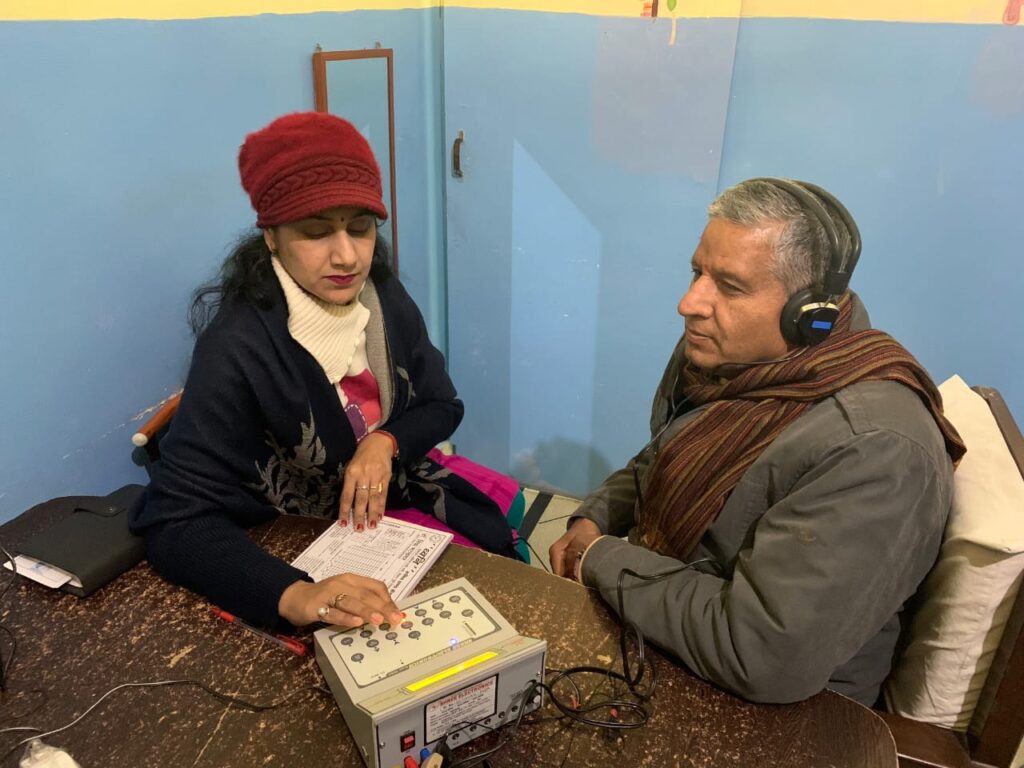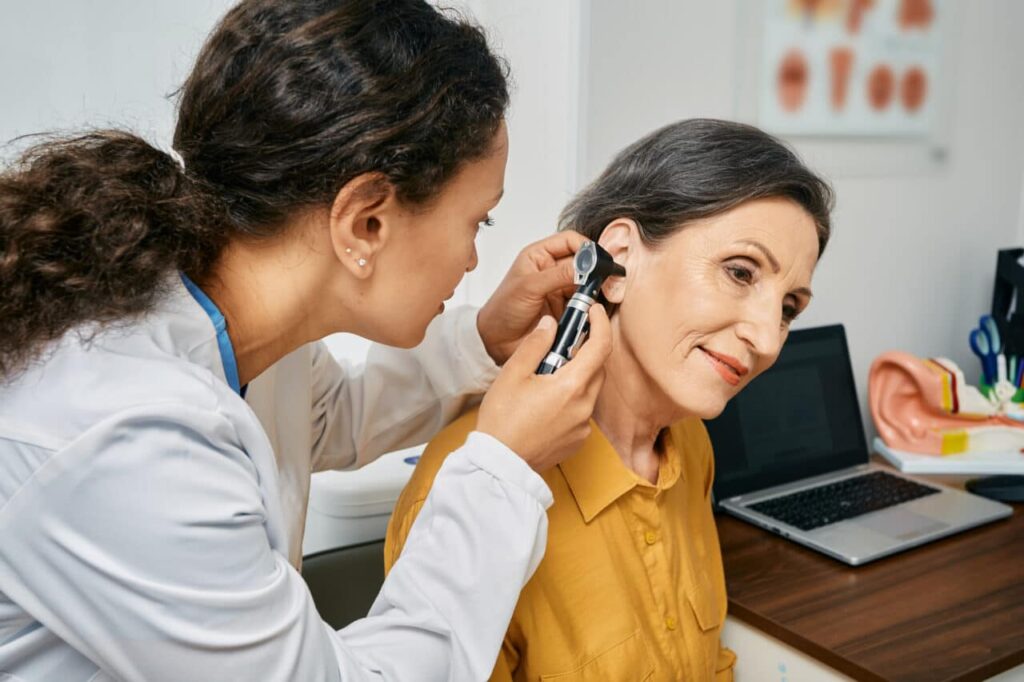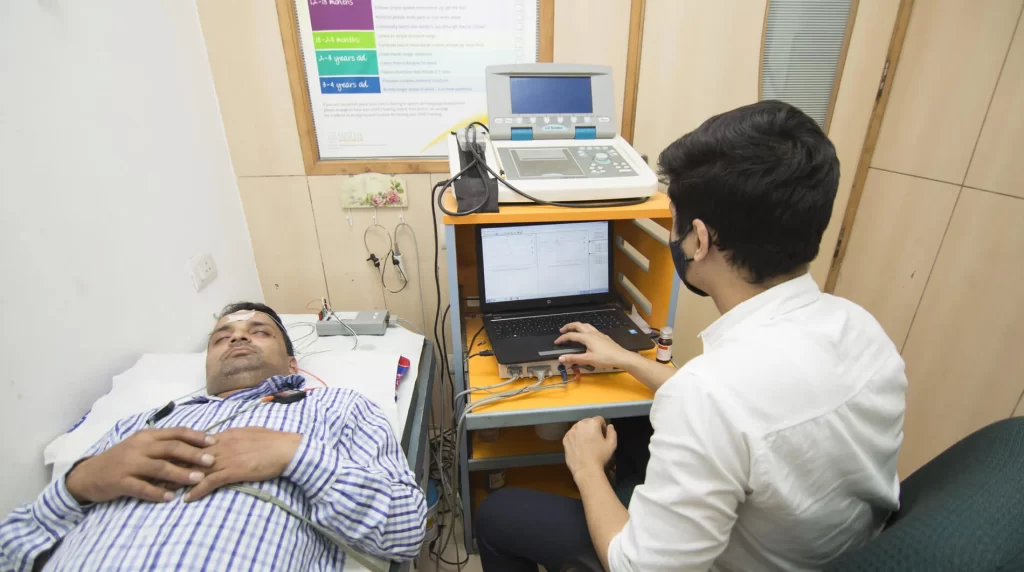Adult Solutions

Adult Solutions
Hearing loss in adults typically progresses slowly, often without noticeable symptoms. Many individuals with hearing loss do not perceive an active problem with their hearing. Instead, they primarily struggle with understanding words due to selective hearing loss for certain sounds.
By relying on context and concentrating on conversations, they can often comprehend words more easily. However, at times, sentences may need to be repeated several times for full understanding. Untreated hearing loss has been associated with Alzheimer’s Disease, Dementia, Tinnitus in the elderly, and an increased risk of falls, diabetes, depression, anxiety, and social isolation.

Adult Solutions
Hearing loss in adults typically progresses slowly, often without noticeable symptoms. Many individuals with hearing loss do not perceive an active problem with their hearing. Instead, they primarily struggle with understanding words due to selective hearing loss for certain sounds. Best hearing test for adults in Saharanpur.
By relying on context and concentrating on conversations, they can often comprehend words more easily. However, at times, sentences may need to be repeated several times for full understanding. Untreated hearing loss has been associated with Alzheimer’s Disease, Dementia, Tinnitus in the elderly, and an increased risk of falls, diabetes, depression, anxiety, and social isolation.
Hearing Aids
Hearing aids are small electronic devices that amplify sound to help people with hearing loss. They can help people hear better in both quiet and noisy situations and can improve speech.
Types of hearing aids-hearing aids come in many styles and types including:-
1. Behind the ear (BTE):- A small plastic case that sits behind the ear can correct moderately to serve the hearing loss.
2. In the ear (ITE):- A shell that fits in the outer part of the ear.
3. In the canal (ITC):- A tiny case that fits partly into the ear canal, but can still be seen.
4. Completely in the canal (CIC):- A very small, cosmetic option.
5. Invisible in the canal (IIC):- A type of hearing aid.
Adult Language Disorder
In adults can be caused by brain injury or diseases or can be development.
Swallowing and feeding disorder:- A feeding disorder refers to a problem in the development of feeding skills. Such as sucking from a breast or bottle, eating from a force chewing, or drinking from a cup.
Causes of hearing loss:- Deafness is usually the result of inner ear or nerve damage. It may be caused by a congenital defect injury disease, certain medication, exposure to loud noise, or age-related wear and tear.
Sign of Hearing Loss:-
1. Trouble understanding people over the phone.
2. Finding it hard to follow discussion when two or more people or talking.
3. Often asking people to repeat themselves.
4. Needing to turn up the volume higher than the other people do.
5. Trouble understanding others because of background noise.
6. Thinking that others seem to mumble.
Prevents of hearing loss in adults
According to data from the World Health Organization (WHO) in 2018, the prevalence of hearing impairment in India is alarmingly high, especially among the elderly population. Specifically, around 67% of individuals aged 60 years and older are affected by some degree of hearing loss. This means that for every 10 elderly people in India, 6 to 7 are likely to experience significant hearing impairment. This widespread issue underscores the urgent need for greater awareness, early detection, and effective management strategies for hearing loss among the aging population. Hearing impairment can lead to numerous challenges, including difficulty in communication, social isolation, and a decline in overall quality of life.

Prevents of hearing loss in adults
According to data from the World Health Organization (WHO) in 2018, the prevalence of hearing impairment in India is alarmingly high, especially among the elderly population.

Specifically, around 67% of individuals aged 60 years and older are affected by some degree of hearing loss. This means that for every 10 elderly people in India, 6 to 7 are likely to experience significant hearing impairment. This widespread issue underscores the urgent need for greater awareness, early detection, and effective management strategies for hearing loss among the aging population. Hearing impairment can lead to numerous challenges, including difficulty in communication, social isolation, and a decline in overall quality of life.

Types and degree of hearing loss
Hearing loss can be categorized into sensorineural, conductive, and mixed. Sensorineural hearing loss is caused by damage to the inner ear or auditory nerve and is often permanent. Conductive hearing loss occurs when sound waves cannot reach the inner ear due to issues in the outer or middle ear and is often treatable. Mixed hearing loss combines both types, requiring a combination of medical, surgical, and hearing aid interventions.

Types and degree of hearing loss
Hearing loss can be categorized into sensorineural, conductive, and mixed. Sensorineural hearing loss is caused by damage to the inner ear or auditory nerve and is often permanent.
Conductive hearing loss occurs when sound waves cannot reach the inner ear due to issues in the outer or middle ear and is often treatable. Mixed hearing loss combines both types, requiring a combination of medical, surgical, and hearing aid interventions. Best hearing test for adults in Saharanpur.
Self Assessment Checklist
You might notice someone talking but struggle to understand the words, with certain sounds seeming excessively loud. It becomes challenging to follow conversations in noisy environments like restaurants or markets, or while walking alongside the speaker. Distinguishing between sounds such as “s,” “sh,” “f,” and “th” can be difficult. You may also experience ringing in the ears (tinnitus), frequently turn up the volume on the television or radio, and often ask people to repeat themselves.

Self Assessment Checklist
You might notice someone talking but struggling to understand the words, with certain sounds seeming excessively loud.

It becomes challenging to follow conversations in noisy environments like restaurants or markets, or while walking alongside the speaker. Distinguishing between sounds such as “s,” “sh,” “f,” and “th” can be difficult. You may also experience ringing in the ears (tinnitus), frequently turn up the volume on the television or radio, and often ask people to repeat themselves.

How to test
Pure Tone Audiometry (PTA) is the primary hearing test used to identify an individual’s hearing threshold levels, determining the degree, type, and configuration of hearing loss, which forms the basis for diagnosis and management. The impedance test is employed to assess the status of the middle ear, aiding in the identification of an appropriate treatment plan. When hearing loss is categorized as sensorineural and untreatable, hearing aid fitting and programming are recommended. Speech Audiometry, a fundamental tool in hearing loss assessment, is used alongside pure-tone audiometry to determine the degree and type of hearing loss. It provides information on word recognition and discomfort or tolerance to speech stimuli, and is conducted in a sound-treated room with a speech audiometer using a standardized wordlist.

How to test
Pure Tone Audiometry (PTA) is the primary hearing test used to identify an individual’s hearing threshold levels, determining the degree, type, and configuration of hearing loss, which forms the basis for diagnosis and management. Best hearing test for adults in Saharanpur.
The impedance test is employed to assess the status of the middle ear, aiding in the identification of an appropriate treatment plan. When hearing loss is categorized as sensorineural and untreatable, hearing aid fitting and programming are recommended. Speech Audiometry, a fundamental tool in hearing loss assessment, is used alongside pure-tone audiometry to determine the degree and type of hearing loss. It provides information on word recognition and discomfort or tolerance to speech stimuli, and is conducted in a sound-treated room with a speech audiometer using a standardized wordlist.
Selecting a Hearing Aid Device
The process of selecting a hearing aid begins with assessing the individual’s hearing loss and auditory needs, considering the environments in which they spend most of their time. The initial selection is based on these factors. Next, the selection is refined by filtering the chosen devices based on required technical features such as the number of channels, noise cancellation, speech rescue, and connectivity. Given that hearing losses are often progressive, it is essential to choose a device with enough capacity to accommodate future changes. The cosmetic appeal is also a significant consideration, with options including CIC, ITC, ITE, RIC, BTE, and body-worn devices, depending on where the device will be worn. Once a suitable device is selected, a trial is conducted to ensure it meets the user’s listening preferences, recognizing that individuals with similar hearing loss.

Selecting a Hearing Aid Device
The process of selecting a hearing aid begins with assessing the individual’s hearing loss and auditory needs, considering the environments in which they spend most of their time. The initial selection is based on these factors.

Next, the selection is refined by filtering the chosen devices based on required technical features such as the number of channels, noise cancellation, speech rescue, and connectivity. Given that hearing losses are often progressive, it is essential to choose a device with enough capacity to accommodate future changes. The cosmetic appeal is also a significant consideration, with options including CIC, ITC, ITE, RIC, BTE, and body-worn devices, depending on where the device will be worn. Once a suitable device is selected, a trial is conducted to ensure it meets the user’s listening preferences, recognizing that individuals with similar hearing loss.

Tinnitus Retraining Programs
Uses Counselling and sound therapy to alter negative responses to tinnitus. It can help people to become used, to tinnitus, and no longer notice the sound it causes. Tinnitus, the perception of noise or ringing in the ears affects about 15 to 20% of people. It is not a condition itself but a symptom of underlying issues such as age-related hearing loss, ear injury, or circulatory system disorders. Tinnitus assessment and sound therapy involve creating an Individual Management Plan (IMP) in collaboration with patients, their families, and caregivers. The IMP should include access to sound therapy (e.g., bedside sound generators), hearing aids, combination hearing aids, and novel devices.
Tinnitus Maskers
Tinnitus Maskers also known as tinnitus noises are devices that produce white noises to cover up or mask internal sounds on tinnitus. They can be small and look like hearing aids, but instead of amplifying external noises, they create a low-volume stream of white noises.

Tinnitus
Uses Counselling and sound therapy to alter negative responses to tinnitus. It can help people to become used, to tinnitus and no longer notice the sound it causes. Tinnitus, the perception of noise or ringing in the ears affects about 15 to 20% of people.
It is not a condition itself but a symptom of underlying issues such as age-related hearing loss, ear injury, or circulatory system disorders. Tinnitus assessment and sound therapy involve creating an Individual Management Plan (IMP) in collaboration with patients, their families, and caregivers. The IMP should include access to sound therapy (e.g., bedside sound generators), hearing aids, combination hearing aids, and novel devices.
Tinnitus Maskers
Tinnitus Maskers also known as tinnitus noises are devices that produce white noises to cover up or mask internal sounds on tinnitus. They can be small and look like hearing aids, but instead of amplifying external noises, they create a low-volume stream of white noises.
Treatment Option
Audiologists and Speech-Language Pathologists (ASLP) are certified to diagnose hearing issues. Medication can only help if the problem is in the middle ear; otherwise, an implant or hearing aid is the only solution for hearing loss. A cochlear implant uses a sound processor worn behind the ear to send sound signals to a receiver and stimulator implanted under the skin, stimulating the auditory nerve with electrodes in the cochlea. BAHA (Bone-Anchored Hearing Aid) combines a sound processor with a small titanium fixture implanted behind the ear, allowing sound to be transferred to a functioning cochlea via direct bone conduction rather than through the middle ear.

Treatment Option
Audiologists and Speech-Language Pathologists (ASLP) are certified to diagnose hearing issues. Medication can only help if the problem is in the middle ear; otherwise, an implant or hearing aid is the only solution for hearing loss.

A cochlear implant uses a sound processor worn behind the ear to send sound signals to a receiver and stimulator implanted under the skin, stimulating the auditory nerve with electrodes in the cochlea. BAHA (Bone-Anchored Hearing Aid) combines a sound processor with a small titanium fixture implanted behind the ear, allowing sound to be transferred to a functioning cochlea via direct bone conduction rather than through the middle ear.

BAHA
A bone-anchored hearing aid (BAHA) is a hearing device that uses bone conduction to transmit sound directly to the inner ear. It’s often used by people who can’t wear other hearing aids, such as those with conductive hearing loss, unilateral hearing loss, single-sided deafness, or chronic ear drainings.
Occupational Therapy
Occupational therapy (OT) is a branch of health care that helps people of all ages who have physical sensory, or cognitive problems. OT can help them regain independence in all areas of their lives.


Misarticulation
Misarticulation is a communication disorder that affects the ability to produce speech sound correctly. It is a common condition that effects both childrens and adults.
Voice Disorders
Voice disorders refer to problems with pitch, volume, tone, or quality of the voice that can make it difficult to speak or be understood. These disorders may result from overuse, infection, vocal cord nodules, or neurological conditions. Common symptoms include hoarseness, a weak or strained voice, and pain while speaking. Treatment depends on the cause and may include voice therapy, medication, or surgery to restore normal voice function and improve communication.


ASSR
Auditory steady-state response (ASSR) is to create an estimated audiogram from which questions regarding hearing loss, and rehabilitation can be answered.
Pure tone Audiometry (PTA)
Pure tone Audiometry is a behavioral test that measures a person’s hearing sensitivity. and identifies their hearing threshold levels.


Impedance Audiometry
Impedance Audiometry is a non-invasive diagnostic test that measures the middle ear’s resistance to sound waves and evaluates the status of the tympanic membrane. It can help identify hearing problems and can be used to diagnose conditions.
Aphasia
Aphasia is a communication disorder that affects a person’s ability to speak, understand, read, or write. It occurs when the language centers of the brain, often in the left hemisphere, are damaged, commonly due to stroke or head injury. People with aphasia may struggle to find words or form sentences but still have clear thinking abilities. Treatment often involves speech therapy to improve communication skills and help individuals regain language abilities over time.

Contact Us

